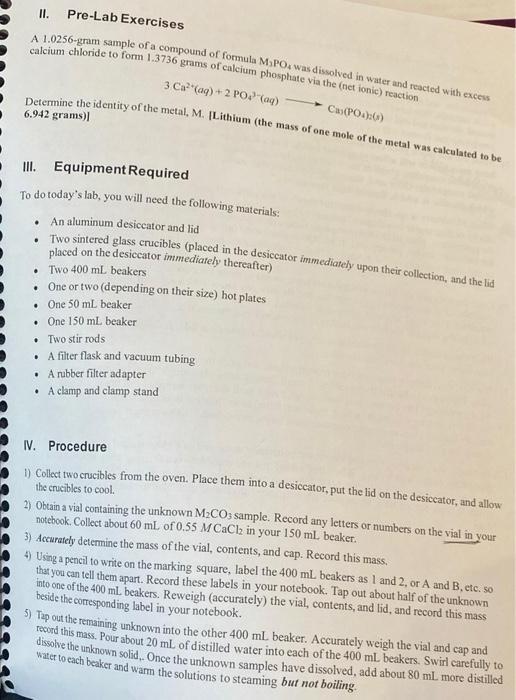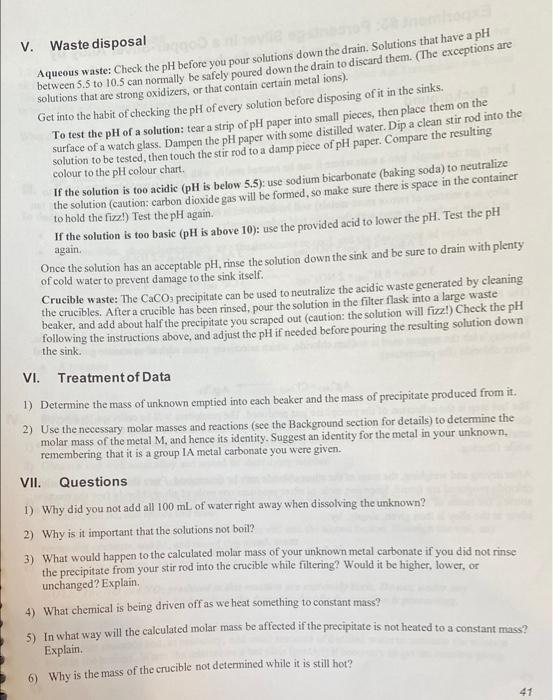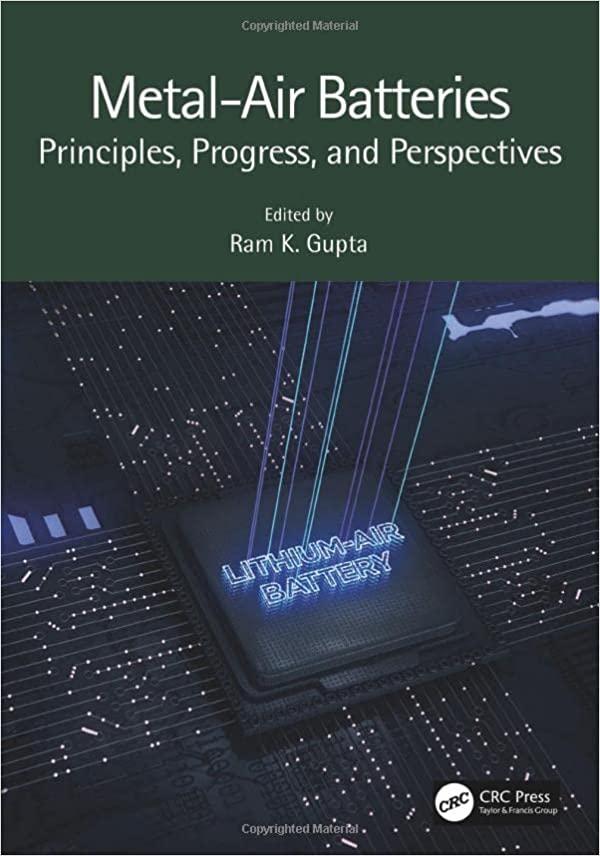Answered step by step
Verified Expert Solution
Question
1 Approved Answer
Experiment #4: Gravimetric Analysis of a Soluble Carbonate 1. Background Chemists are quite often concemed with which elements are present in a compound (qualitative analysis)




Experiment #4: Gravimetric Analysis of a Soluble Carbonate 1. Background Chemists are quite often concemed with which elements are present in a compound (qualitative analysis) and how much of each element or group is present (quantitative analysis). There are two common methods used when performing a quantitative analysis: By titration (volumetric analysis), and by precipitation (gravimetric analysis). A gravimetric analysis consists of a few simple steps: 1. Dissolve the chemical that contains the group or clement of interest. 2. Add another chemical that reacts with only one part of what you've just dissolved, forming a precipitate; i.e., an insoluble compound. 3. Filter, dry, cool, and weigh the precipitate. These are the three basic steps involved in the lab today. What you're given is a compound that has the formula MC03 (where "M" is some group IA metal), and the object of today's lab is to determine the molar mass of the unknown metal carbonate M2CO3 and the identity of the unknown element "M". You will first dissolve the metal carbonate in some suitable solvent. Water works well, and when dissolved in water, cach unit of M.CO, dissociates into two M ions, and one carbonate (CO;-)ion. The M'ions are fairly unreactive (spectator ions), but the carbonate ions will react with aqueous calcium ions to form a precipitate that may be easily collected, dried, and weighed: Complete chemical equation: CaCl(aq) + M2CO3(aq) CaCO3(s)+2 MCWaq) Net ionic equation: Ca**(aq) + CO2(aq) CaCO3(5) Does this help us? Yes, and here's how: We start by finding the mass of the precipitate we've formed. We can use this mass to calculate the moles of precipitate formed By stoichiometry, we then know the moles of carbonate son that were initially present to react. All those moles of carbonate ion came from the M:CO: compound; since one mole of M_COs produces one mole of carbonate ion, we now know the moles of MCO. We also (because we weighed it before) know the mass of M-CO, that corresponds to those moles we've just determined. Because we know the mass and the moles, we can determine the molar mass (g/mol). Once we have the molar mass of M200s, we just subtract off the molar mass of one mole of carbon and three moles of oxygen to determine what (twice) the mass of M" is. Matching up the molar mass of M with one of the elements on the periodic table accomplishes our goal. 38 II. Pre-Lab Exercises A 1.0256-gram sample of a compound of formula MPO, was dissolved in water and reacted with excess calcium chloride to form 1.3736 grams of calcium phosphate via the (net ionic) reaction 3 Ca?(aq) + 2 PO.Vaq) C#)(PO4)36) Determine the identity of the metal, M. Lithium (the mass of one mole of the metal was calculated to be 6.942 grams) III. Equipment Required To do today's lab, you will need the following materials: An aluminum desiccator and lid Two sintered glass crucibles (placed in the desiccator immediately upon their collection, and the lid placed on the desiccator immediately thereafter) Two 400 ml beakers . One or two (depending on their size) hot plates . . One 50 mL beaker One 150 ml. beaker . Two stir rods A filter flask and vacuum tubing A rubber filter adapter A clamp and clamp stand IV. Procedure 1) Collect two crucibles from the oven. Place them into a desiccator, put the lid on the desiccator, and allow the crucibles to cool. 2) Obtain a vial containing the unknown M2COsample. Record any letters or numbers on the vial in your notebook. Collect about 60 m. of 0.55 M CaCl in your 150 ml, beaker. 3) Accurately determine the mass of the vial, contents, and cap. Record this mass. 4) Using a pencil to write on the marking square, label the 400 ml beakers as 1 and 2, or A and B, etc. so that you can tell them apart. Record these labels in your notebook. Tap out about half of the unknown into one of the 400 ml beakers. Reweigh (accurately) the vial, contents, and lid, and record this mass beside the corresponding label in your notebook. 5) Tap out the remaining unknown into the other 400 ml beaker. Accurately weigh the vial and cap record this mass. Pour about 20 mL of distilled water into each of the 400 ml beakers. Swirl carefully to dissolve the unknown solid, Once the unknown samples have dissolved, add about 80 ml more distilled water to cach beaker and warm the solutions to steaming but not boiling. and Be careful that you do not spill any of the solutions you have just made, or your final result will be inaccurate, 6) Obtain about 60 mL of 0.55 M CaCl. Once the solutions have started steaming, reduce the heat to medium-low and add 30 mL of 0.55 M CaCl to each solution. Stir each solution with its own stir rod for a few seconds, then leave the stir rod in the solutions and allow them to heat for another 30 minutes (record the start and end time in your notebook). Do not stir the solution during this time so that the precipitate just formed will coagulate. 2.32 3.16 42: 7) Note: Do not touch your crucibles with your bare hands when handling them. Your fingerprints have mass and so will affect your final result. Use a Kimwipe to handle the crucible. While your precipitates coagulate, check to see whether the two crucibles you collected at the start of the lab have cooled completely. Once cool, accurately determine their mass. Be sure you have some way of knowing which crucible is which. Record these two masses. 8), When 30 minutes is up, check to see that the all of the carbonate anion has precipitated from solution. Do this by adding one or two drops of calcium chloride solution to the superatant liquid (the liquid above the precipitate). If no additional precipitate forms, then the calcium chloride was added in excess and all the carbonate ion has precipitated. If additional precipitate forms when you test your solutions, continue to add small amounts of CaCl2 until no further precipitate is observed. Take the beakers just successfully tested and put them into an ice bath to cool the contents. 9) Once the solutions (and their precipitates) have cooled to room temperature, carefully filter them into the crucibles as demonstrated by your instructor. Be sure you know which solution is going into which crucible! Very small amounts of ice-cold distilled water may be used to help rinse any precipitate that sticks to the walls of the 400 mL beaker or the stir rod into the crucible. 10) Place the crucibles in the desiccator to dry (without the desiccator lid), and then place the desiccator containing your crucibles into the oven. 11) The next day, remove your crucibles from the oven, and once they are cool, (accurately) reweigh them, using Kimwipes to handle the crucibles. Record these masses. (If enough time were available in the lab, we'd go through two or three heat-cool-weigh cycles until the mass recorded had reached a constant value; this heating-cooling-weighing cycle is referred to as "heating to constant mass". We're assuming that, by heating them overnight, constant mass has been reached.) Set your crucibles aside for cleaning during the next lab period. 12) To clean your crucibles, first use the rubber policeman at the end of a glass stir rod to scrape out the precipitate onto a watch glass. When that's done, put the crucibles on a filtering setup like you used last week and draw about 25 mL of 6 MHCl through each of them, and then at least 200 mL of distilled water to rinse out the HCI. Show your lab instructor the cleaned crucibles to obtain a signature for your data. V. Waste disposal Aqueous waste: Check the pH before you pour solutions down the drain. Solutions that have a pH between 5.5 to 10.5 can normally be safely poured down the drain to discard them. (The exceptions are solutions that are strong oxidizers, or that contain certain metal ions), Get into the habit of checking the pH of every solution before disposing of it in the sinks. To test the pH of a solution: tear a strip of pH paper into small pieces, then place them on the surface of a watch glass. Dampen the pH paper with some distilled water. Dip a clean stir rod into the solution to be tested, then touch the star rod to a damp piece of pH paper. Compare the resulting colour to the pH colour chart. If the solution is too acidic (pH is below 5.5): use sodium bicarbonate (baking soda) to neutralize the solution (caution: carbon dioxide gas will be formed, so make sure there is space in the container to hold the fizz!) Test the pH again. If the solution is too basic (pH is above 10): use the provided acid to lower the pH. Test the pH again. Once the solution has an acceptable pH, rinse the solution down the sink and be sure to drain with plenty of cold water to prevent damage to the sink itself. Crucible waste: The Caco, precipitate can be used to neutralize the acidic waste generated by cleaning the crucibles. After a crucible has been rinsed, pour the solution in the filter flask into a large waste beaker, and add about half the precipitate you scraped out (caution: the solution will fizz!) Check the pH following the instructions above, and adjust the pH if needed before pouring the resulting solution down the sink. VI. Treatment of Data 1) Determine the mass of unknown emptied into each beaker and the mass of precipitate produced from it. 2) Use the necessary molar masses and reactions (see the Background section for details) to determine the molar mass of the metal M. and hence its identity. Suggest an identity for the metal in your unknown. remembering that it is a group IA metal carbonate you were given. VII. Questions 1) Why did you not add all 100 mL of water right away when dissolving the unknown? 2) Why is it important that the solutions not boil? 3) What would happen to the calculated molar mass of your unknown metal carbonate if you did not rinse the precipitate from your stir rod into the crucible while filtering? Would it be higher, lower, or unchanged? Explain 4) What chemical is being driven off as we heat something to constant mass? 5) In what way will the calculated molar masa be affected if the precipitate is not heated to a constant mass? Explain. 6) Why is the mass of the crucible not determined while it is still hot
Step by Step Solution
There are 3 Steps involved in it
Step: 1

Get Instant Access to Expert-Tailored Solutions
See step-by-step solutions with expert insights and AI powered tools for academic success
Step: 2

Step: 3

Ace Your Homework with AI
Get the answers you need in no time with our AI-driven, step-by-step assistance
Get Started


